Analyzing Sustainable Energy Goals and Development Targets
VerifiedAdded on 2021/09/15
|9
|2237
|38
Essay
AI Summary
This essay delves into the crucial role of sustainable energy in achieving the Sustainable Development Goals (SDGs) outlined by the United Nations. It begins by defining sustainable development and then examines how energy underpins the success of each of the 17 SDGs. The essay highlights the significant impact of energy on poverty reduction, hunger eradication, health, education, gender equality, water sanitation, and overall economic growth. It identifies key energy-related challenges, such as efficiency issues and the need for utility-scale renewables, while also proposing potential solutions like train transportation, solar PV rooftops, alternative vehicles, and smart grids. The essay emphasizes the necessity of global partnerships to overcome energy challenges and achieve a sustainable future by 2030, concluding that effective energy sustainability is essential for transforming the world and improving livelihoods.
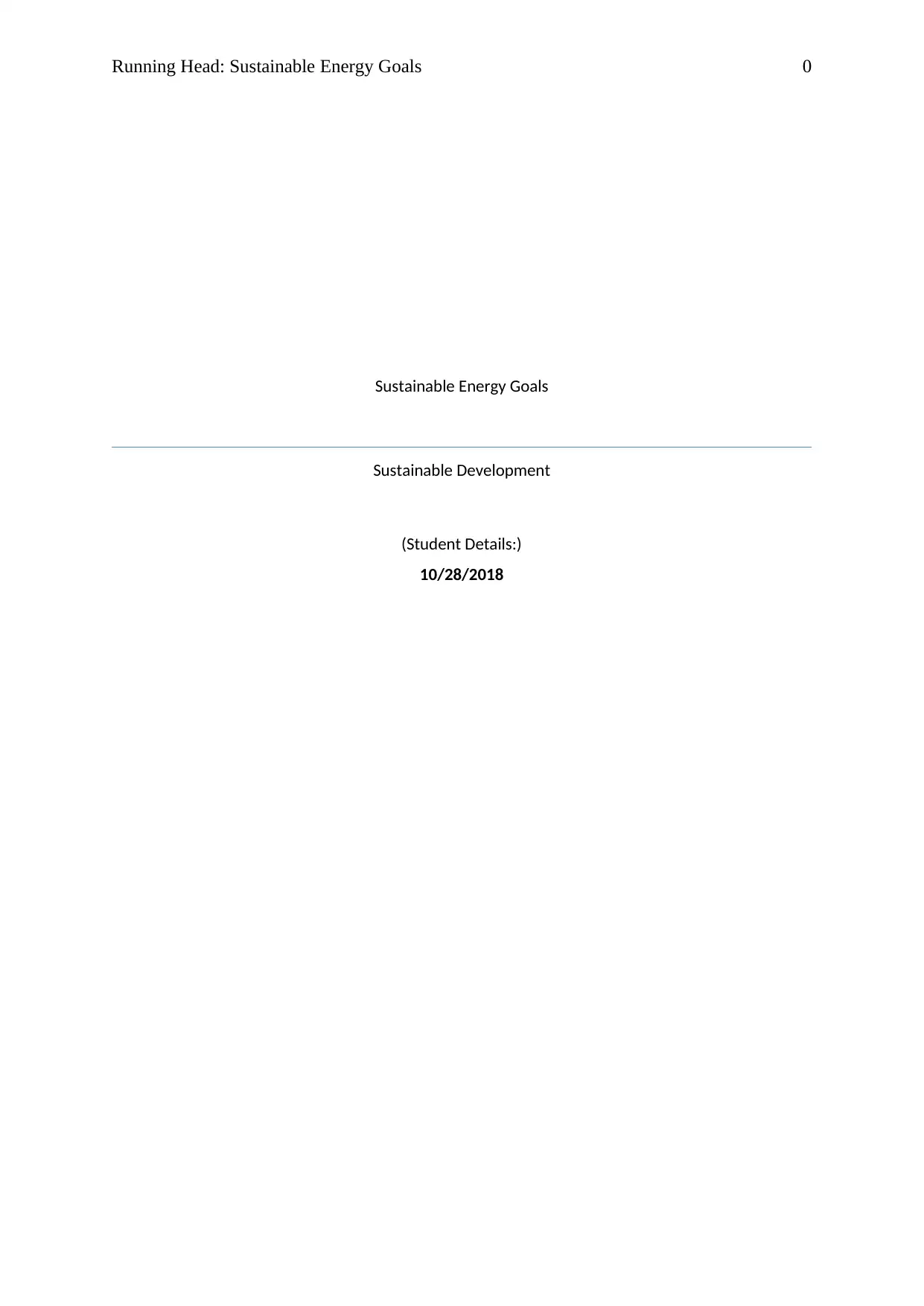
Running Head: Sustainable Energy Goals 0
Sustainable Energy Goals
Sustainable Development
(Student Details:)
10/28/2018
Sustainable Energy Goals
Sustainable Development
(Student Details:)
10/28/2018
Paraphrase This Document
Need a fresh take? Get an instant paraphrase of this document with our AI Paraphraser
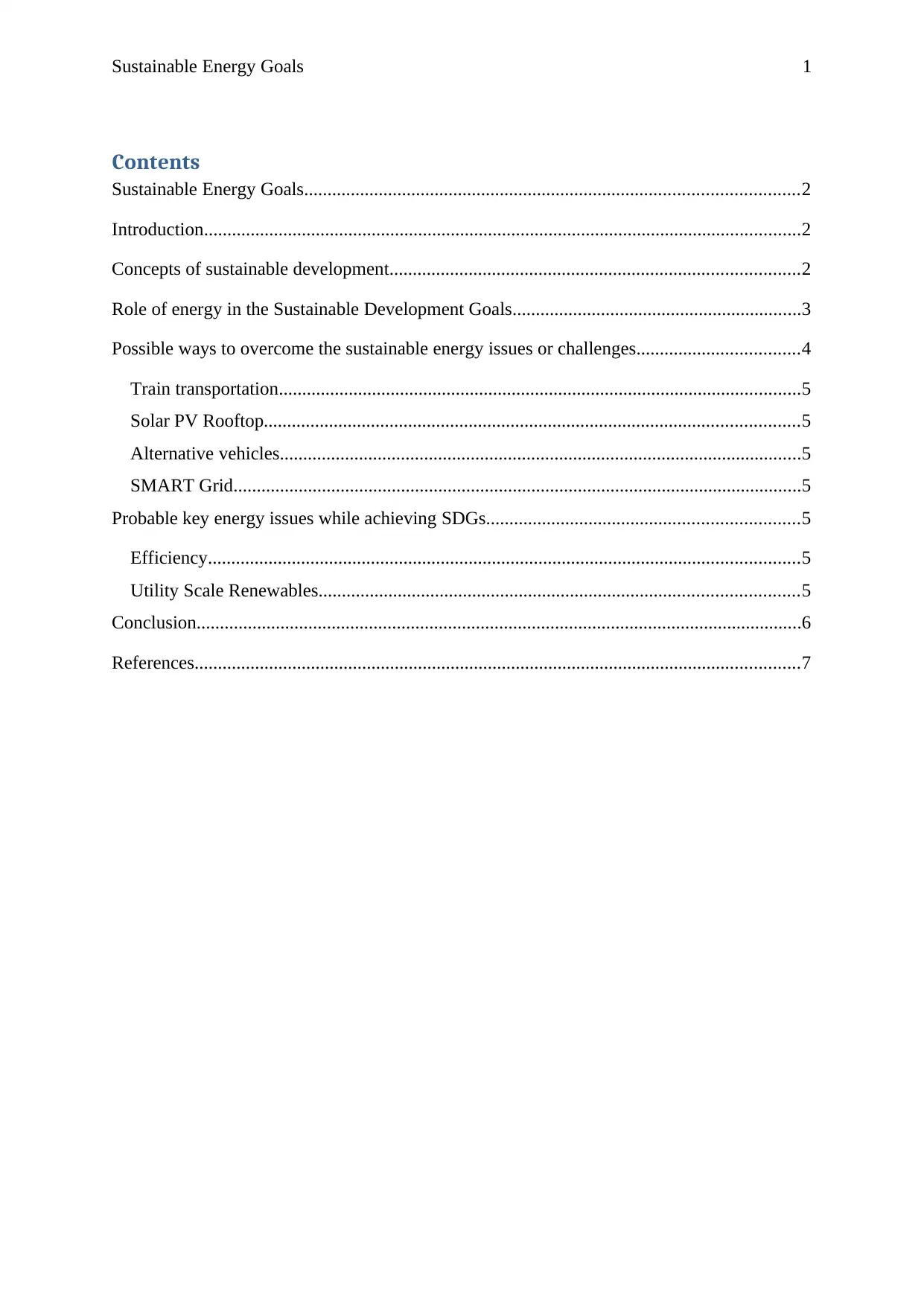
Sustainable Energy Goals 1
Contents
Sustainable Energy Goals..........................................................................................................2
Introduction................................................................................................................................2
Concepts of sustainable development........................................................................................2
Role of energy in the Sustainable Development Goals..............................................................3
Possible ways to overcome the sustainable energy issues or challenges...................................4
Train transportation................................................................................................................5
Solar PV Rooftop...................................................................................................................5
Alternative vehicles................................................................................................................5
SMART Grid..........................................................................................................................5
Probable key energy issues while achieving SDGs...................................................................5
Efficiency...............................................................................................................................5
Utility Scale Renewables.......................................................................................................5
Conclusion..................................................................................................................................6
References..................................................................................................................................7
Contents
Sustainable Energy Goals..........................................................................................................2
Introduction................................................................................................................................2
Concepts of sustainable development........................................................................................2
Role of energy in the Sustainable Development Goals..............................................................3
Possible ways to overcome the sustainable energy issues or challenges...................................4
Train transportation................................................................................................................5
Solar PV Rooftop...................................................................................................................5
Alternative vehicles................................................................................................................5
SMART Grid..........................................................................................................................5
Probable key energy issues while achieving SDGs...................................................................5
Efficiency...............................................................................................................................5
Utility Scale Renewables.......................................................................................................5
Conclusion..................................................................................................................................6
References..................................................................................................................................7
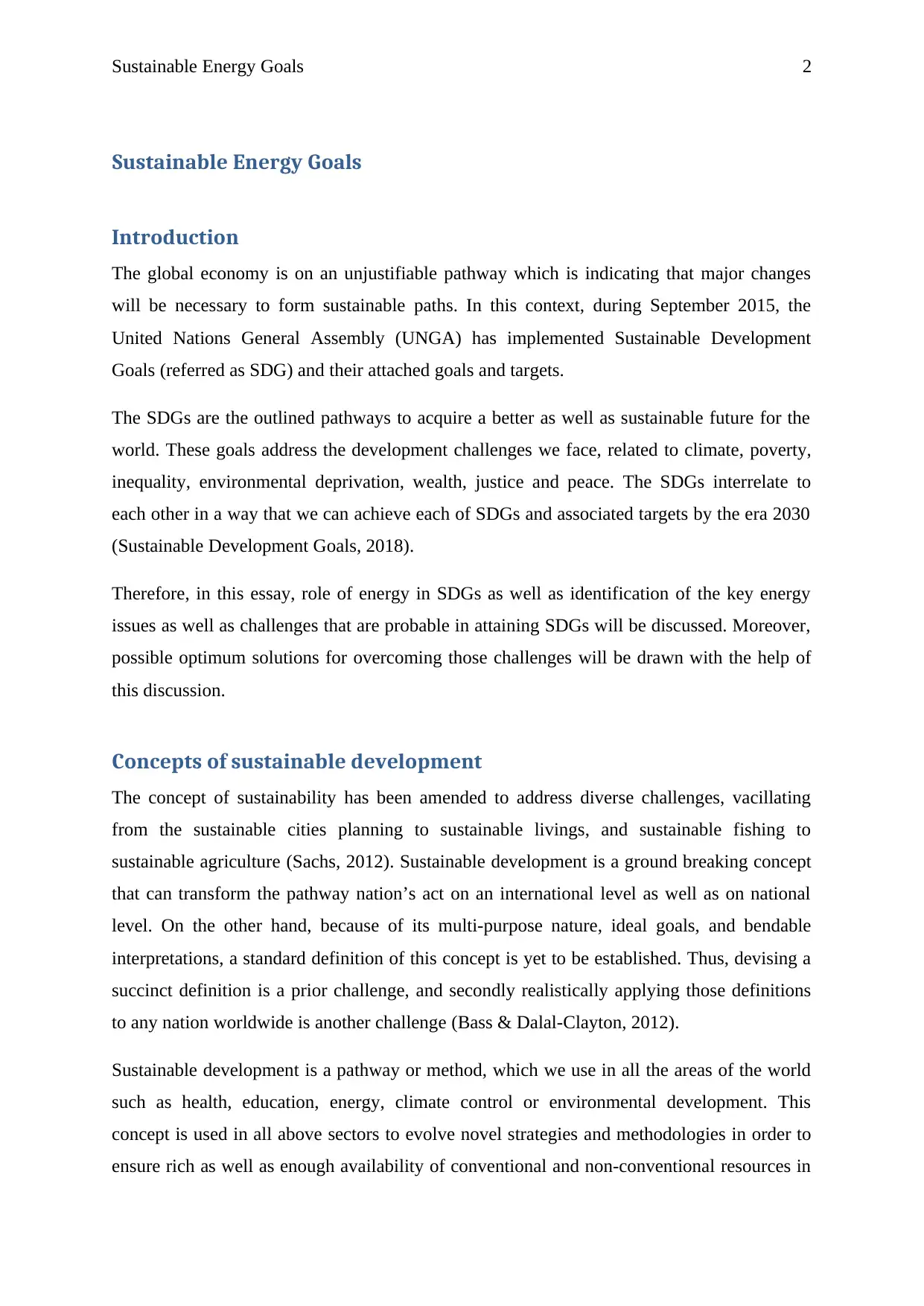
Sustainable Energy Goals 2
Sustainable Energy Goals
Introduction
The global economy is on an unjustifiable pathway which is indicating that major changes
will be necessary to form sustainable paths. In this context, during September 2015, the
United Nations General Assembly (UNGA) has implemented Sustainable Development
Goals (referred as SDG) and their attached goals and targets.
The SDGs are the outlined pathways to acquire a better as well as sustainable future for the
world. These goals address the development challenges we face, related to climate, poverty,
inequality, environmental deprivation, wealth, justice and peace. The SDGs interrelate to
each other in a way that we can achieve each of SDGs and associated targets by the era 2030
(Sustainable Development Goals, 2018).
Therefore, in this essay, role of energy in SDGs as well as identification of the key energy
issues as well as challenges that are probable in attaining SDGs will be discussed. Moreover,
possible optimum solutions for overcoming those challenges will be drawn with the help of
this discussion.
Concepts of sustainable development
The concept of sustainability has been amended to address diverse challenges, vacillating
from the sustainable cities planning to sustainable livings, and sustainable fishing to
sustainable agriculture (Sachs, 2012). Sustainable development is a ground breaking concept
that can transform the pathway nation’s act on an international level as well as on national
level. On the other hand, because of its multi-purpose nature, ideal goals, and bendable
interpretations, a standard definition of this concept is yet to be established. Thus, devising a
succinct definition is a prior challenge, and secondly realistically applying those definitions
to any nation worldwide is another challenge (Bass & Dalal-Clayton, 2012).
Sustainable development is a pathway or method, which we use in all the areas of the world
such as health, education, energy, climate control or environmental development. This
concept is used in all above sectors to evolve novel strategies and methodologies in order to
ensure rich as well as enough availability of conventional and non-conventional resources in
Sustainable Energy Goals
Introduction
The global economy is on an unjustifiable pathway which is indicating that major changes
will be necessary to form sustainable paths. In this context, during September 2015, the
United Nations General Assembly (UNGA) has implemented Sustainable Development
Goals (referred as SDG) and their attached goals and targets.
The SDGs are the outlined pathways to acquire a better as well as sustainable future for the
world. These goals address the development challenges we face, related to climate, poverty,
inequality, environmental deprivation, wealth, justice and peace. The SDGs interrelate to
each other in a way that we can achieve each of SDGs and associated targets by the era 2030
(Sustainable Development Goals, 2018).
Therefore, in this essay, role of energy in SDGs as well as identification of the key energy
issues as well as challenges that are probable in attaining SDGs will be discussed. Moreover,
possible optimum solutions for overcoming those challenges will be drawn with the help of
this discussion.
Concepts of sustainable development
The concept of sustainability has been amended to address diverse challenges, vacillating
from the sustainable cities planning to sustainable livings, and sustainable fishing to
sustainable agriculture (Sachs, 2012). Sustainable development is a ground breaking concept
that can transform the pathway nation’s act on an international level as well as on national
level. On the other hand, because of its multi-purpose nature, ideal goals, and bendable
interpretations, a standard definition of this concept is yet to be established. Thus, devising a
succinct definition is a prior challenge, and secondly realistically applying those definitions
to any nation worldwide is another challenge (Bass & Dalal-Clayton, 2012).
Sustainable development is a pathway or method, which we use in all the areas of the world
such as health, education, energy, climate control or environmental development. This
concept is used in all above sectors to evolve novel strategies and methodologies in order to
ensure rich as well as enough availability of conventional and non-conventional resources in
⊘ This is a preview!⊘
Do you want full access?
Subscribe today to unlock all pages.

Trusted by 1+ million students worldwide
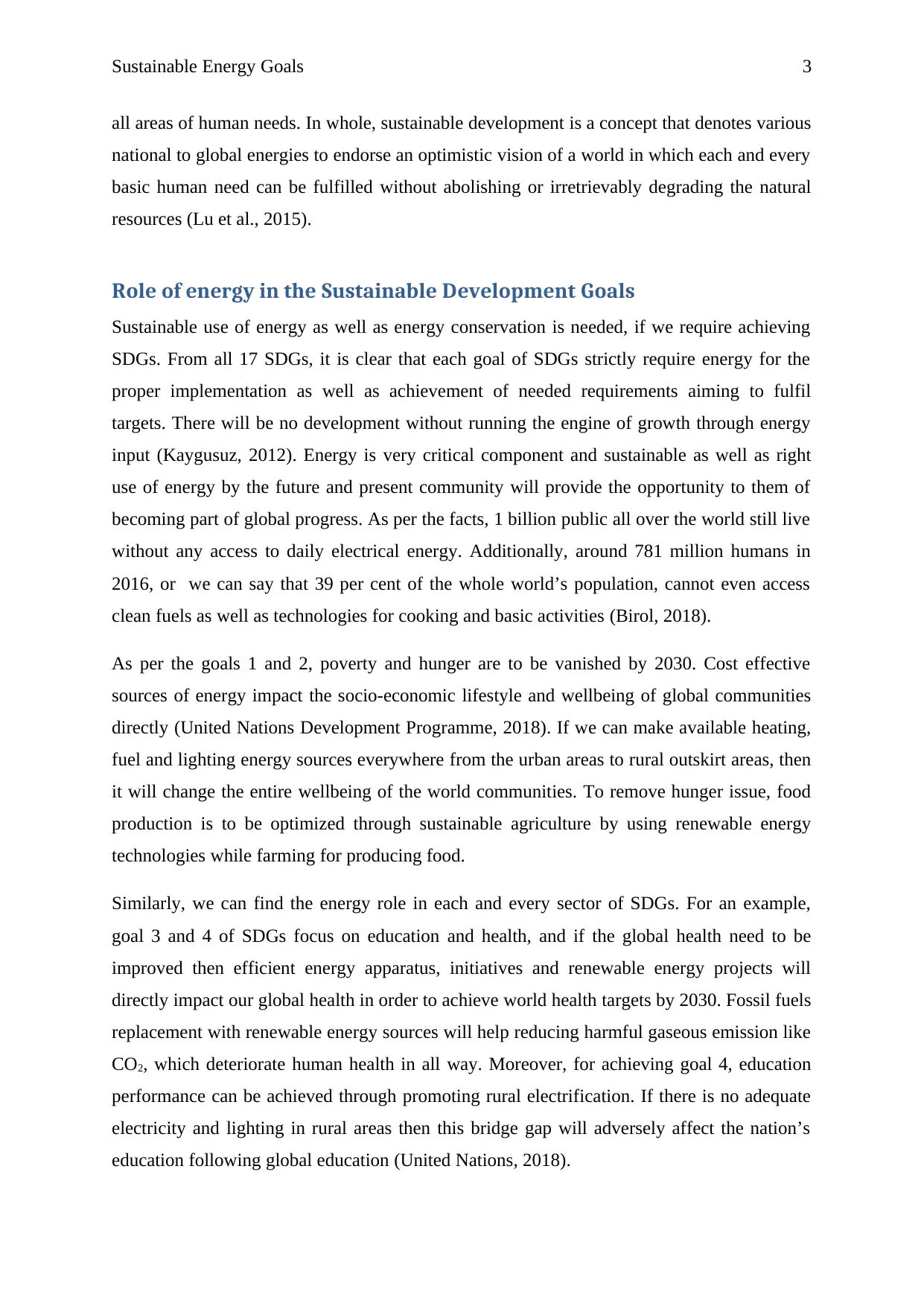
Sustainable Energy Goals 3
all areas of human needs. In whole, sustainable development is a concept that denotes various
national to global energies to endorse an optimistic vision of a world in which each and every
basic human need can be fulfilled without abolishing or irretrievably degrading the natural
resources (Lu et al., 2015).
Role of energy in the Sustainable Development Goals
Sustainable use of energy as well as energy conservation is needed, if we require achieving
SDGs. From all 17 SDGs, it is clear that each goal of SDGs strictly require energy for the
proper implementation as well as achievement of needed requirements aiming to fulfil
targets. There will be no development without running the engine of growth through energy
input (Kaygusuz, 2012). Energy is very critical component and sustainable as well as right
use of energy by the future and present community will provide the opportunity to them of
becoming part of global progress. As per the facts, 1 billion public all over the world still live
without any access to daily electrical energy. Additionally, around 781 million humans in
2016, or we can say that 39 per cent of the whole world’s population, cannot even access
clean fuels as well as technologies for cooking and basic activities (Birol, 2018).
As per the goals 1 and 2, poverty and hunger are to be vanished by 2030. Cost effective
sources of energy impact the socio-economic lifestyle and wellbeing of global communities
directly (United Nations Development Programme, 2018). If we can make available heating,
fuel and lighting energy sources everywhere from the urban areas to rural outskirt areas, then
it will change the entire wellbeing of the world communities. To remove hunger issue, food
production is to be optimized through sustainable agriculture by using renewable energy
technologies while farming for producing food.
Similarly, we can find the energy role in each and every sector of SDGs. For an example,
goal 3 and 4 of SDGs focus on education and health, and if the global health need to be
improved then efficient energy apparatus, initiatives and renewable energy projects will
directly impact our global health in order to achieve world health targets by 2030. Fossil fuels
replacement with renewable energy sources will help reducing harmful gaseous emission like
CO2, which deteriorate human health in all way. Moreover, for achieving goal 4, education
performance can be achieved through promoting rural electrification. If there is no adequate
electricity and lighting in rural areas then this bridge gap will adversely affect the nation’s
education following global education (United Nations, 2018).
all areas of human needs. In whole, sustainable development is a concept that denotes various
national to global energies to endorse an optimistic vision of a world in which each and every
basic human need can be fulfilled without abolishing or irretrievably degrading the natural
resources (Lu et al., 2015).
Role of energy in the Sustainable Development Goals
Sustainable use of energy as well as energy conservation is needed, if we require achieving
SDGs. From all 17 SDGs, it is clear that each goal of SDGs strictly require energy for the
proper implementation as well as achievement of needed requirements aiming to fulfil
targets. There will be no development without running the engine of growth through energy
input (Kaygusuz, 2012). Energy is very critical component and sustainable as well as right
use of energy by the future and present community will provide the opportunity to them of
becoming part of global progress. As per the facts, 1 billion public all over the world still live
without any access to daily electrical energy. Additionally, around 781 million humans in
2016, or we can say that 39 per cent of the whole world’s population, cannot even access
clean fuels as well as technologies for cooking and basic activities (Birol, 2018).
As per the goals 1 and 2, poverty and hunger are to be vanished by 2030. Cost effective
sources of energy impact the socio-economic lifestyle and wellbeing of global communities
directly (United Nations Development Programme, 2018). If we can make available heating,
fuel and lighting energy sources everywhere from the urban areas to rural outskirt areas, then
it will change the entire wellbeing of the world communities. To remove hunger issue, food
production is to be optimized through sustainable agriculture by using renewable energy
technologies while farming for producing food.
Similarly, we can find the energy role in each and every sector of SDGs. For an example,
goal 3 and 4 of SDGs focus on education and health, and if the global health need to be
improved then efficient energy apparatus, initiatives and renewable energy projects will
directly impact our global health in order to achieve world health targets by 2030. Fossil fuels
replacement with renewable energy sources will help reducing harmful gaseous emission like
CO2, which deteriorate human health in all way. Moreover, for achieving goal 4, education
performance can be achieved through promoting rural electrification. If there is no adequate
electricity and lighting in rural areas then this bridge gap will adversely affect the nation’s
education following global education (United Nations, 2018).
Paraphrase This Document
Need a fresh take? Get an instant paraphrase of this document with our AI Paraphraser
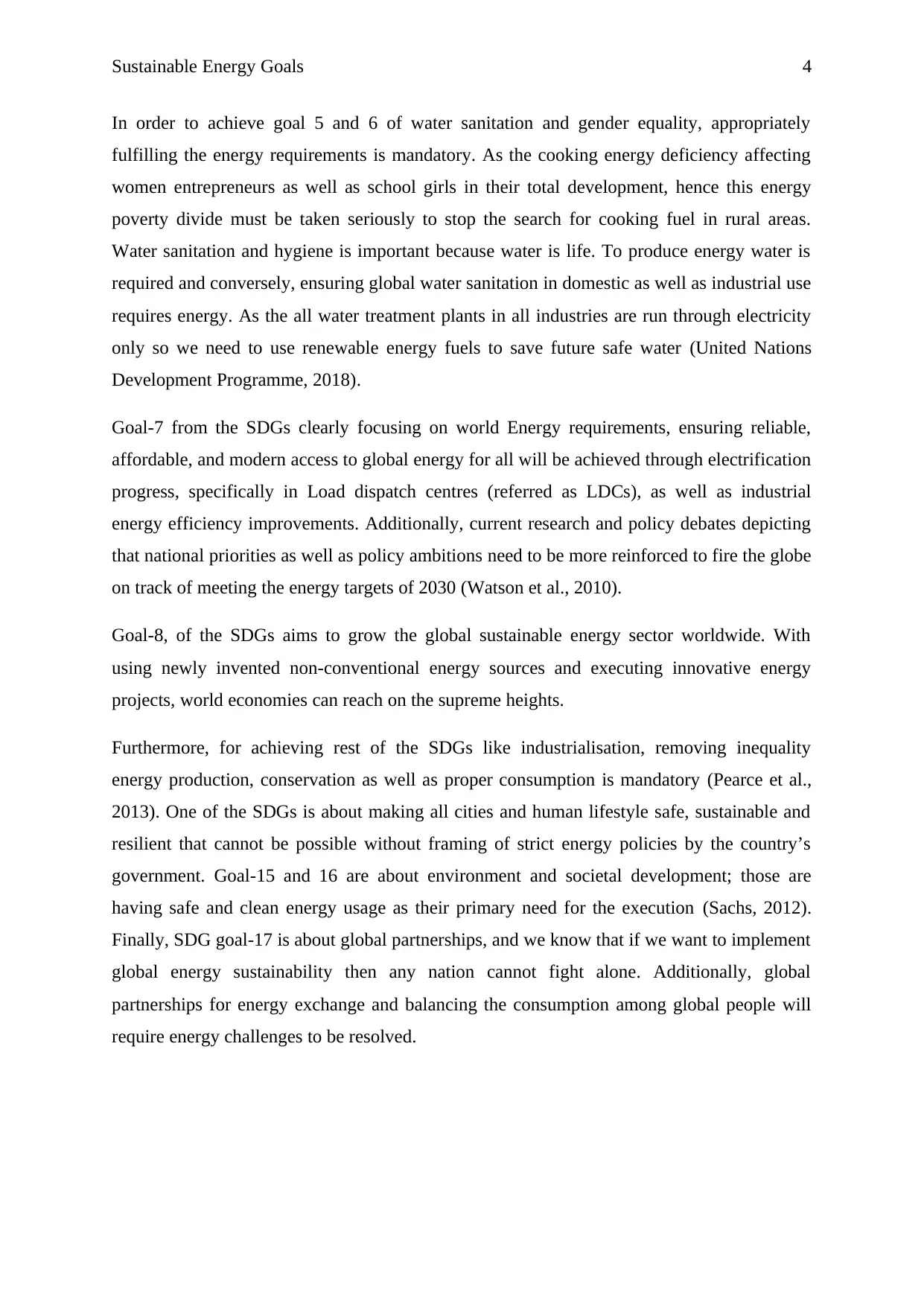
Sustainable Energy Goals 4
In order to achieve goal 5 and 6 of water sanitation and gender equality, appropriately
fulfilling the energy requirements is mandatory. As the cooking energy deficiency affecting
women entrepreneurs as well as school girls in their total development, hence this energy
poverty divide must be taken seriously to stop the search for cooking fuel in rural areas.
Water sanitation and hygiene is important because water is life. To produce energy water is
required and conversely, ensuring global water sanitation in domestic as well as industrial use
requires energy. As the all water treatment plants in all industries are run through electricity
only so we need to use renewable energy fuels to save future safe water (United Nations
Development Programme, 2018).
Goal-7 from the SDGs clearly focusing on world Energy requirements, ensuring reliable,
affordable, and modern access to global energy for all will be achieved through electrification
progress, specifically in Load dispatch centres (referred as LDCs), as well as industrial
energy efficiency improvements. Additionally, current research and policy debates depicting
that national priorities as well as policy ambitions need to be more reinforced to fire the globe
on track of meeting the energy targets of 2030 (Watson et al., 2010).
Goal-8, of the SDGs aims to grow the global sustainable energy sector worldwide. With
using newly invented non-conventional energy sources and executing innovative energy
projects, world economies can reach on the supreme heights.
Furthermore, for achieving rest of the SDGs like industrialisation, removing inequality
energy production, conservation as well as proper consumption is mandatory (Pearce et al.,
2013). One of the SDGs is about making all cities and human lifestyle safe, sustainable and
resilient that cannot be possible without framing of strict energy policies by the country’s
government. Goal-15 and 16 are about environment and societal development; those are
having safe and clean energy usage as their primary need for the execution (Sachs, 2012).
Finally, SDG goal-17 is about global partnerships, and we know that if we want to implement
global energy sustainability then any nation cannot fight alone. Additionally, global
partnerships for energy exchange and balancing the consumption among global people will
require energy challenges to be resolved.
In order to achieve goal 5 and 6 of water sanitation and gender equality, appropriately
fulfilling the energy requirements is mandatory. As the cooking energy deficiency affecting
women entrepreneurs as well as school girls in their total development, hence this energy
poverty divide must be taken seriously to stop the search for cooking fuel in rural areas.
Water sanitation and hygiene is important because water is life. To produce energy water is
required and conversely, ensuring global water sanitation in domestic as well as industrial use
requires energy. As the all water treatment plants in all industries are run through electricity
only so we need to use renewable energy fuels to save future safe water (United Nations
Development Programme, 2018).
Goal-7 from the SDGs clearly focusing on world Energy requirements, ensuring reliable,
affordable, and modern access to global energy for all will be achieved through electrification
progress, specifically in Load dispatch centres (referred as LDCs), as well as industrial
energy efficiency improvements. Additionally, current research and policy debates depicting
that national priorities as well as policy ambitions need to be more reinforced to fire the globe
on track of meeting the energy targets of 2030 (Watson et al., 2010).
Goal-8, of the SDGs aims to grow the global sustainable energy sector worldwide. With
using newly invented non-conventional energy sources and executing innovative energy
projects, world economies can reach on the supreme heights.
Furthermore, for achieving rest of the SDGs like industrialisation, removing inequality
energy production, conservation as well as proper consumption is mandatory (Pearce et al.,
2013). One of the SDGs is about making all cities and human lifestyle safe, sustainable and
resilient that cannot be possible without framing of strict energy policies by the country’s
government. Goal-15 and 16 are about environment and societal development; those are
having safe and clean energy usage as their primary need for the execution (Sachs, 2012).
Finally, SDG goal-17 is about global partnerships, and we know that if we want to implement
global energy sustainability then any nation cannot fight alone. Additionally, global
partnerships for energy exchange and balancing the consumption among global people will
require energy challenges to be resolved.
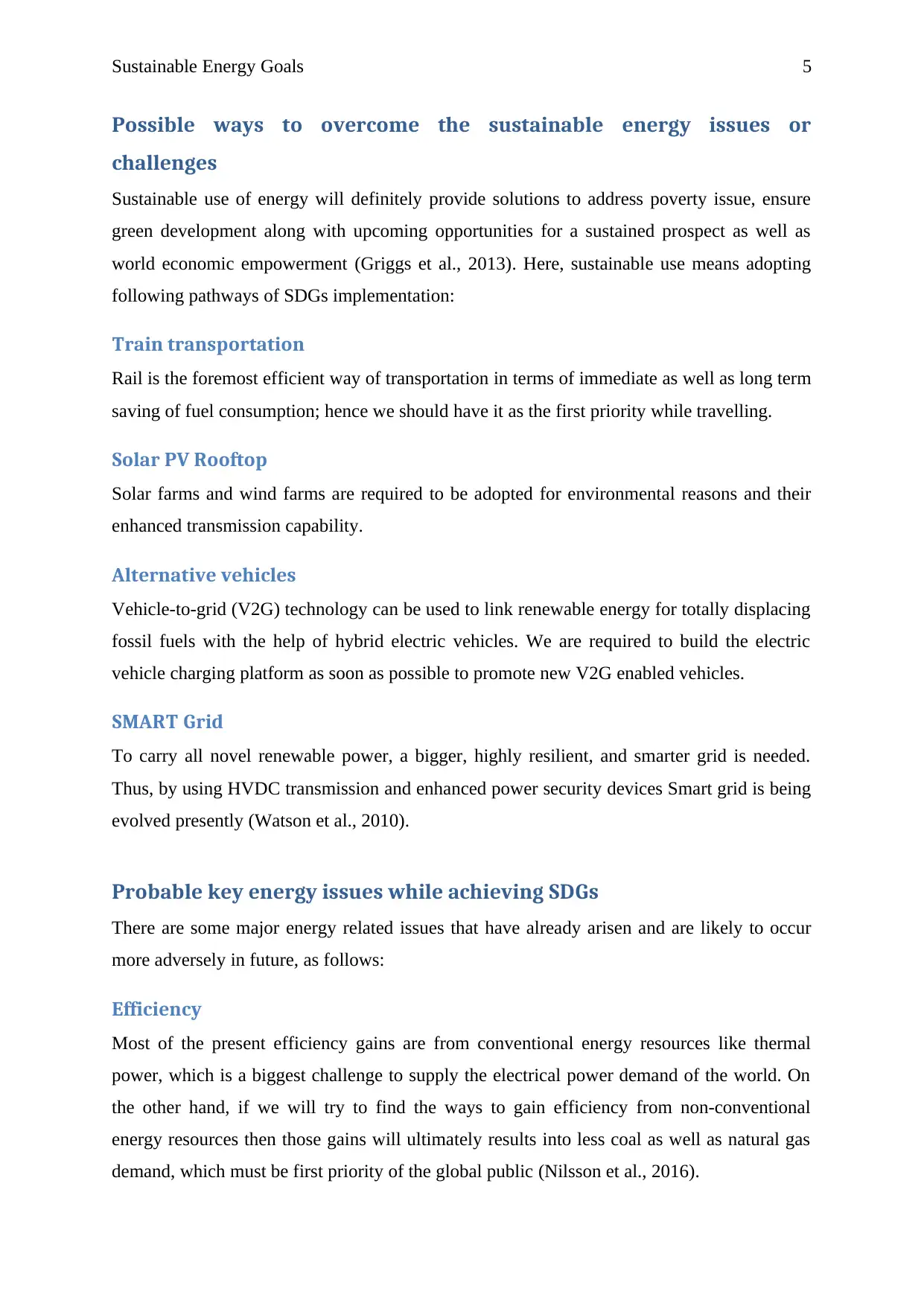
Sustainable Energy Goals 5
Possible ways to overcome the sustainable energy issues or
challenges
Sustainable use of energy will definitely provide solutions to address poverty issue, ensure
green development along with upcoming opportunities for a sustained prospect as well as
world economic empowerment (Griggs et al., 2013). Here, sustainable use means adopting
following pathways of SDGs implementation:
Train transportation
Rail is the foremost efficient way of transportation in terms of immediate as well as long term
saving of fuel consumption; hence we should have it as the first priority while travelling.
Solar PV Rooftop
Solar farms and wind farms are required to be adopted for environmental reasons and their
enhanced transmission capability.
Alternative vehicles
Vehicle-to-grid (V2G) technology can be used to link renewable energy for totally displacing
fossil fuels with the help of hybrid electric vehicles. We are required to build the electric
vehicle charging platform as soon as possible to promote new V2G enabled vehicles.
SMART Grid
To carry all novel renewable power, a bigger, highly resilient, and smarter grid is needed.
Thus, by using HVDC transmission and enhanced power security devices Smart grid is being
evolved presently (Watson et al., 2010).
Probable key energy issues while achieving SDGs
There are some major energy related issues that have already arisen and are likely to occur
more adversely in future, as follows:
Efficiency
Most of the present efficiency gains are from conventional energy resources like thermal
power, which is a biggest challenge to supply the electrical power demand of the world. On
the other hand, if we will try to find the ways to gain efficiency from non-conventional
energy resources then those gains will ultimately results into less coal as well as natural gas
demand, which must be first priority of the global public (Nilsson et al., 2016).
Possible ways to overcome the sustainable energy issues or
challenges
Sustainable use of energy will definitely provide solutions to address poverty issue, ensure
green development along with upcoming opportunities for a sustained prospect as well as
world economic empowerment (Griggs et al., 2013). Here, sustainable use means adopting
following pathways of SDGs implementation:
Train transportation
Rail is the foremost efficient way of transportation in terms of immediate as well as long term
saving of fuel consumption; hence we should have it as the first priority while travelling.
Solar PV Rooftop
Solar farms and wind farms are required to be adopted for environmental reasons and their
enhanced transmission capability.
Alternative vehicles
Vehicle-to-grid (V2G) technology can be used to link renewable energy for totally displacing
fossil fuels with the help of hybrid electric vehicles. We are required to build the electric
vehicle charging platform as soon as possible to promote new V2G enabled vehicles.
SMART Grid
To carry all novel renewable power, a bigger, highly resilient, and smarter grid is needed.
Thus, by using HVDC transmission and enhanced power security devices Smart grid is being
evolved presently (Watson et al., 2010).
Probable key energy issues while achieving SDGs
There are some major energy related issues that have already arisen and are likely to occur
more adversely in future, as follows:
Efficiency
Most of the present efficiency gains are from conventional energy resources like thermal
power, which is a biggest challenge to supply the electrical power demand of the world. On
the other hand, if we will try to find the ways to gain efficiency from non-conventional
energy resources then those gains will ultimately results into less coal as well as natural gas
demand, which must be first priority of the global public (Nilsson et al., 2016).
⊘ This is a preview!⊘
Do you want full access?
Subscribe today to unlock all pages.

Trusted by 1+ million students worldwide
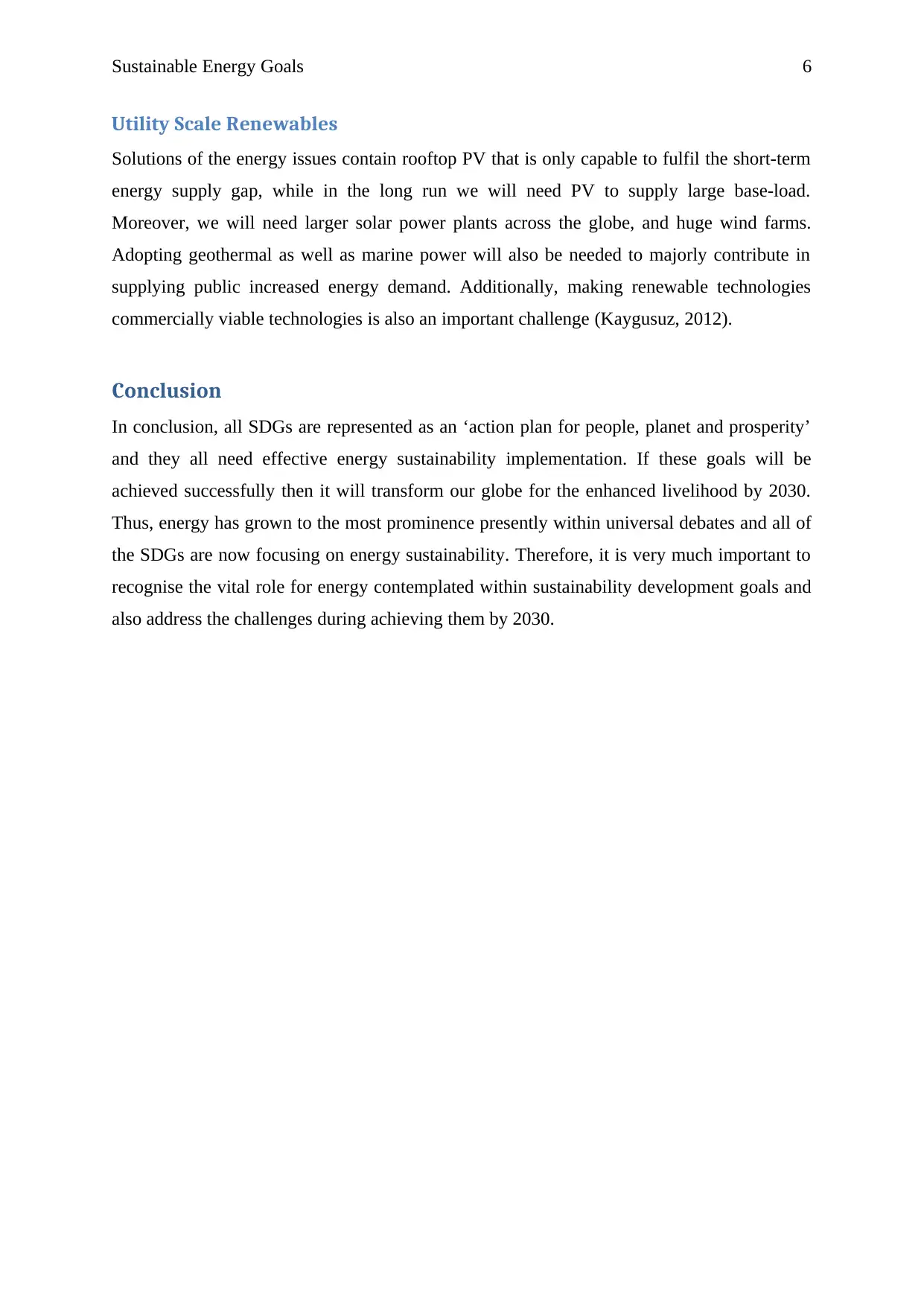
Sustainable Energy Goals 6
Utility Scale Renewables
Solutions of the energy issues contain rooftop PV that is only capable to fulfil the short-term
energy supply gap, while in the long run we will need PV to supply large base-load.
Moreover, we will need larger solar power plants across the globe, and huge wind farms.
Adopting geothermal as well as marine power will also be needed to majorly contribute in
supplying public increased energy demand. Additionally, making renewable technologies
commercially viable technologies is also an important challenge (Kaygusuz, 2012).
Conclusion
In conclusion, all SDGs are represented as an ‘action plan for people, planet and prosperity’
and they all need effective energy sustainability implementation. If these goals will be
achieved successfully then it will transform our globe for the enhanced livelihood by 2030.
Thus, energy has grown to the most prominence presently within universal debates and all of
the SDGs are now focusing on energy sustainability. Therefore, it is very much important to
recognise the vital role for energy contemplated within sustainability development goals and
also address the challenges during achieving them by 2030.
Utility Scale Renewables
Solutions of the energy issues contain rooftop PV that is only capable to fulfil the short-term
energy supply gap, while in the long run we will need PV to supply large base-load.
Moreover, we will need larger solar power plants across the globe, and huge wind farms.
Adopting geothermal as well as marine power will also be needed to majorly contribute in
supplying public increased energy demand. Additionally, making renewable technologies
commercially viable technologies is also an important challenge (Kaygusuz, 2012).
Conclusion
In conclusion, all SDGs are represented as an ‘action plan for people, planet and prosperity’
and they all need effective energy sustainability implementation. If these goals will be
achieved successfully then it will transform our globe for the enhanced livelihood by 2030.
Thus, energy has grown to the most prominence presently within universal debates and all of
the SDGs are now focusing on energy sustainability. Therefore, it is very much important to
recognise the vital role for energy contemplated within sustainability development goals and
also address the challenges during achieving them by 2030.
Paraphrase This Document
Need a fresh take? Get an instant paraphrase of this document with our AI Paraphraser
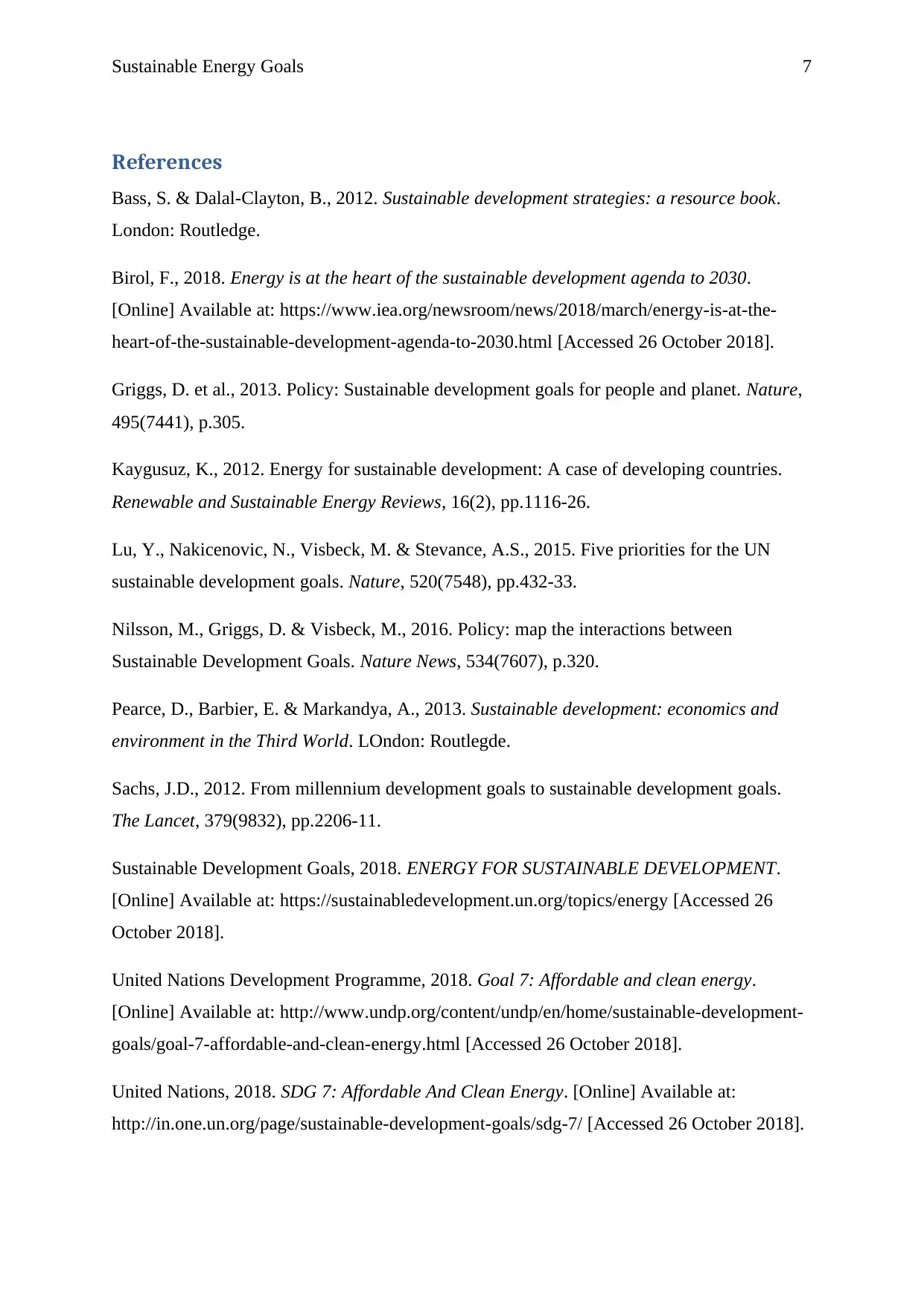
Sustainable Energy Goals 7
References
Bass, S. & Dalal-Clayton, B., 2012. Sustainable development strategies: a resource book.
London: Routledge.
Birol, F., 2018. Energy is at the heart of the sustainable development agenda to 2030.
[Online] Available at: https://www.iea.org/newsroom/news/2018/march/energy-is-at-the-
heart-of-the-sustainable-development-agenda-to-2030.html [Accessed 26 October 2018].
Griggs, D. et al., 2013. Policy: Sustainable development goals for people and planet. Nature,
495(7441), p.305.
Kaygusuz, K., 2012. Energy for sustainable development: A case of developing countries.
Renewable and Sustainable Energy Reviews, 16(2), pp.1116-26.
Lu, Y., Nakicenovic, N., Visbeck, M. & Stevance, A.S., 2015. Five priorities for the UN
sustainable development goals. Nature, 520(7548), pp.432-33.
Nilsson, M., Griggs, D. & Visbeck, M., 2016. Policy: map the interactions between
Sustainable Development Goals. Nature News, 534(7607), p.320.
Pearce, D., Barbier, E. & Markandya, A., 2013. Sustainable development: economics and
environment in the Third World. LOndon: Routlegde.
Sachs, J.D., 2012. From millennium development goals to sustainable development goals.
The Lancet, 379(9832), pp.2206-11.
Sustainable Development Goals, 2018. ENERGY FOR SUSTAINABLE DEVELOPMENT.
[Online] Available at: https://sustainabledevelopment.un.org/topics/energy [Accessed 26
October 2018].
United Nations Development Programme, 2018. Goal 7: Affordable and clean energy.
[Online] Available at: http://www.undp.org/content/undp/en/home/sustainable-development-
goals/goal-7-affordable-and-clean-energy.html [Accessed 26 October 2018].
United Nations, 2018. SDG 7: Affordable And Clean Energy. [Online] Available at:
http://in.one.un.org/page/sustainable-development-goals/sdg-7/ [Accessed 26 October 2018].
References
Bass, S. & Dalal-Clayton, B., 2012. Sustainable development strategies: a resource book.
London: Routledge.
Birol, F., 2018. Energy is at the heart of the sustainable development agenda to 2030.
[Online] Available at: https://www.iea.org/newsroom/news/2018/march/energy-is-at-the-
heart-of-the-sustainable-development-agenda-to-2030.html [Accessed 26 October 2018].
Griggs, D. et al., 2013. Policy: Sustainable development goals for people and planet. Nature,
495(7441), p.305.
Kaygusuz, K., 2012. Energy for sustainable development: A case of developing countries.
Renewable and Sustainable Energy Reviews, 16(2), pp.1116-26.
Lu, Y., Nakicenovic, N., Visbeck, M. & Stevance, A.S., 2015. Five priorities for the UN
sustainable development goals. Nature, 520(7548), pp.432-33.
Nilsson, M., Griggs, D. & Visbeck, M., 2016. Policy: map the interactions between
Sustainable Development Goals. Nature News, 534(7607), p.320.
Pearce, D., Barbier, E. & Markandya, A., 2013. Sustainable development: economics and
environment in the Third World. LOndon: Routlegde.
Sachs, J.D., 2012. From millennium development goals to sustainable development goals.
The Lancet, 379(9832), pp.2206-11.
Sustainable Development Goals, 2018. ENERGY FOR SUSTAINABLE DEVELOPMENT.
[Online] Available at: https://sustainabledevelopment.un.org/topics/energy [Accessed 26
October 2018].
United Nations Development Programme, 2018. Goal 7: Affordable and clean energy.
[Online] Available at: http://www.undp.org/content/undp/en/home/sustainable-development-
goals/goal-7-affordable-and-clean-energy.html [Accessed 26 October 2018].
United Nations, 2018. SDG 7: Affordable And Clean Energy. [Online] Available at:
http://in.one.un.org/page/sustainable-development-goals/sdg-7/ [Accessed 26 October 2018].

Sustainable Energy Goals 8
Watson, R.T., Boudreau, M.C. & Chen, A.J., 2010. Information systems and environmentally
sustainable development: energy informatics and new directions for the IS community. MIS
Quarterly, pp.23-38.
Watson, R.T., Boudreau, M.C. & Chen, A.J., 2010. Information systems and environmentally
sustainable development: energy informatics and new directions for the IS community. MIS
Quarterly, pp.23-38.
⊘ This is a preview!⊘
Do you want full access?
Subscribe today to unlock all pages.

Trusted by 1+ million students worldwide
1 out of 9
Related Documents
Your All-in-One AI-Powered Toolkit for Academic Success.
+13062052269
info@desklib.com
Available 24*7 on WhatsApp / Email
![[object Object]](/_next/static/media/star-bottom.7253800d.svg)
Unlock your academic potential
Copyright © 2020–2025 A2Z Services. All Rights Reserved. Developed and managed by ZUCOL.




